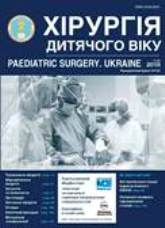Exstrophy of the bladder: status update on the problem (a literature review)
DOI:
https://doi.org/10.15574/PS.2018.60.100Keywords:
children, bladder exstrophy, treatment, long-term outcomesAbstract
A literature review in the past five years on the subject of bladder exstrophy in patients of different age groups is presented. The paper studies the matters of aetiopathogenesis, epidemiology, diagnosis, treatment, complications, as well as afterhistory (20-30 years).References
Chayka VK, Zheleznaya AA, Chayka KV i dr. (2014). Problemyi patsientok s ekstrofiey mochevogo puzyirya v reproduktivnom vozraste. Medyko-sotsialni problemy simi. 19;1:22–26.
Deans R, Banks F, Liao LM et al. (2012, June). Reproductive outcomes in women with classic bladder exstrophy: an observational cross-sectional study. American Journal of Obstetrics & Gynecology. 496e1-496e6
Ebert A, Scheuering S, Schott G et al. (2005). Psychosocial and psychosexual development in childhood and adolescence within the exstrophy-epispadias complex. J Urol. 174:1094–1098. https://doi.org/10.1097/01.ju.0000169171.97538.ed; PMid:16094067
Ebert AK, Schott G, Bals-Pratsch M et al. (2010). Long-term follow-up of male patients after reconstruction of the bladdereexstrophye epispadias complex: Psychosocial status, continence, renal and genital function. J Urol. 6: 6–10.
Etta OE, Ituen M. (2015, Sep. 15). Perioperative Challenges in Repeat Bladder Exstrophy Repair – Case Report. OA Maced J Med Sci. 3(3):432–435. https://doi.org/10.3889/oamjms.2015.047; PMid:27275265 PMCid:PMC4877834
Gupta AD, Goel SK, Woodhouse C R J et al. (2014). Examining long-term outcomes of bladder exstrophy: a 20-year follow-up. BJU Int. 113: 137–141. https://doi.org/10.1111/bju.12389; PMid:24053354
Inouye BM, Massanyi EZ, Carlo HD et al. (2013). Modern Management of Bladder Exstrophy Repair. Curr Urol Rep. 14:359–365. https://doi.org/10.1007/s11934-013-0332-y; PMid:23686356
Lloyd JC, Wiener JS, Gargollo PC et al. (2013). Contemporary Epidemiological Trends in Complex Congenital Genitourinary Anomalies. J Urol. 190:1590–1595. https://doi.org/10.1016/j.juro.2013.04.034; PMid:23791903
Mahfuz I, Darling T, Wilkins S et al. (2013). New insights into the pathogenesis of bladder exstrophyeepispadias complex. J Pediatr Urol. 996–1005. https://doi.org/10.1016/j.jpurol.2013.05.001; 10. Mushtaq I, Garriboli M, Smeulders N et al. (2013). Primary Bladder Exstrophy Closure in Neonates: Challenging the Traditions. J Urol. 191:193–198. https://doi.org/10.1016/j.juro.2013.07.020; 11. Park W, Zwink N, Ro.sch WH et al. (2015). Sexual function in adult patients with classic bladder exstrophy: A multicenter study. J Pediatr Urol. 125.e1-125.e6. https://doi.org/10.1016/j.jpurol.2015.02.001
Reddy SS, Inouye BM, Anele UA et al. (2015). Sexual Health Outcomes in Adult Complete Male Epispadias Patients. J Urol 194:1091–1095. https://doi.org/10.1016/j.juro.2015.04.082; PMid:25916676
Salem HK, Eisa M. (2012). Long-term Follow-up (18–35 years) of Male Patients with History of Bladder Exstrophy (BE) Repair in Childhood: Erectile Function and Fertility Potential Outcome. J Sex Med. 9:1466–1472. https://doi.org/10.1111/j.1743-6109.2011.02536.x; PMid:22024420
Valerio E, Vanzo V, Zaramella P et al. (2015). Exstrophy–Epispadias Complex in a Newborn: Case Report and Review of the Literature. American Journal of Perinatology Reports. 5;2:183–187. https://doi.org/10.1055/s-0035-1556759; PMid:26495181 PMCid:PMC4603851
Downloads
Issue
Section
License
The policy of the Journal “PAEDIATRIC SURGERY. UKRAINE” is compatible with the vast majority of funders' of open access and self-archiving policies. The journal provides immediate open access route being convinced that everyone – not only scientists - can benefit from research results, and publishes articles exclusively under open access distribution, with a Creative Commons Attribution-Noncommercial 4.0 international license(СС BY-NC).
Authors transfer the copyright to the Journal “PAEDIATRIC SURGERY.UKRAINE” when the manuscript is accepted for publication. Authors declare that this manuscript has not been published nor is under simultaneous consideration for publication elsewhere. After publication, the articles become freely available on-line to the public.
Readers have the right to use, distribute, and reproduce articles in any medium, provided the articles and the journal are properly cited.
The use of published materials for commercial purposes is strongly prohibited.

